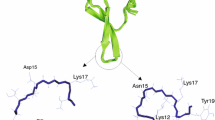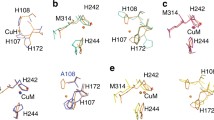Abstract
The role of the pentapeptide, NHSFM, derived from the surface exposed part of the metal ion binding loop of the subunit II of cytochrome c oxidase on the maturation of the binuclear purple CuA center of the enzyme has been investigated using several experimental and computational methods. The copper ion was found to form 1:1 complex of the pentapeptide with a binding constant ~ 104 M−1 to 105 M−1, where a 4 ligand coordination from the peptide in a type 2 copper center was revealed. The pH dependence of the metal–peptide was associated with a \({\text{p}}K_{{\text{a}}}\) of ~ 10 suggesting deprotonation of the N-terminal amine. EXAFS studies as well as DFT calculations of the metal–peptide complexes revealed pH dependent changes in the metal–ligand bond distances. Spectroscopic properties of the metal peptides calculated from TDDFT studies agreed with the experimental results. Restrained molecular dynamics (RMD) simulations indicated coordination of a carbonyl oxygen from the asparagine (N) side chain and of water molecules apart from histidine (H), methionine (M) and terminal amine of asparagine (N) in a distorted square planar geometry of Cu–NHSFM. Analyses of the backbone distances as well as B-factors for the metal peptide suggested that the peptide backbone becomes more compact and rigid on binding of the metal ion. This indicated that binding of copper ion to this pentapeptide in the protein possibly cause movement of the protein backbone bringing other coordinating residues closer to the copper ion, and thus hel** in sequential uptake of copper ions to the protein.
Graphic abstract










Similar content being viewed by others
References
Finney LA, O’Halloran TV (2003) Transition metal speciation in the cell: insights from the chemistry of metal ion receptors. Science 300(5621):931–936
Babor M et al (2008) Prediction of transition metal-binding sites from apo protein structures. Proteins 70(1):208–217
Deng Z et al (2015) Mechanistic insights into metal ion activation and operator recognition by the ferric uptake regulator. Nat Commun 6:7642
Abriata LA et al (2008) Mechanism of Cu(A) assembly. Nat Chem Biol 4(10):599–601
Canonica F et al (2019) Structural basis and mechanism for metallochaperone-assisted assembly of the CuA center in cytochrome oxidase. Sci Adv 5(7):eaaw8478
Ghosh MK, Basak P, Mazumdar S (2013) Mechanism of copper incorporation in subunit II of cytochrome C oxidase from Thermus thermophilus: identification of intermediate species. Biochemistry 52(27):4620–4635
Williams PA et al (1999) The CuA domain of Thermus thermophilus ba3-type cytochrome c oxidase at 1.6 A resolution. Nat Struct Mol Biol 6(6):509–516
Yoshikawa S, Shimada A (2015) Reaction mechanism of cytochrome c oxidase. Chem Rev 115(4):1936–1989
Bertini I et al (1996) The CuA center of a soluble domain from Thermus Cytochrome ba3. An NMR investigation of the paramagnetic protein. J Am Chem Soc 118(46):11658–11659
Siluvai GS et al (2010) Anatomy of a red copper center: spectroscopic identification and reactivity of the copper centers of Bacillus subtilis Sco and its Cys-to-Ala variants. J Am Chem Soc 132(14):5215–5226
Haltia T et al (2003) Crystal structure of nitrous oxide reductase from Paracoccus denitrificans at 1.6 A resolution. Biochem J 369(Pt 1):77–88
Wilson TD et al (2011) Kinetics of copper incorporation into a biosynthetic purple CuA azurin: characterization of red, blue, and a new intermediate species. J Am Chem Soc 133(51):20778–20792
Dutta Gupta D, Usharani D, Mazumdar S (2016) Mono-nuclear copper complexes mimicking the intermediates for the binuclear copper center of the subunit II of cytochrome oxidase: a peptide based approach. Dalton Trans 45(44):17624–17632
Stoll S, Schweiger A (2006) EasySpin, a comprehensive software package for spectral simulation and analysis in EPR. J Magn Reson 178(1):42–55
Poswal AK et al (2014) Commissioning and first results of scanning type EXAFS beamline (BL-09) at INDUS-2 synchrotron source. AIP Conf Proc 1591(1):649–651
Basu S et al (2014) A comprehensive facility for EXAFS measurements at the INDUS-2 synchrotron source at RRCAT, Indore, India. J Phys Conf Ser 493(1):012032
Yanai T, Tew DP, Handy NC (2004) A new hybrid exchange–correlation functional using the Coulomb-attenuating method (CAM-B3LYP). Chem Phys Lett 393(1–3):51–57
Frisch MJ et al (2013) Gaussian 09 program. Gaussian Inc, Wallingford
Tomasi J, Mennucci B, Cammi R (2005) Quantum mechanical continuum solvation models. Chem Rev 105(8):2999–3094
Lu T, Chen F (2012) Multiwfn: a multifunctional wavefunction analyzer. J Comput Chem 33(5):580–592
Dennington R, Keith T, Millam NJ (2009) GaussView 5.0. Semichem Inc., Shawnee Mission
Neese F (2004) Sum-over-states based multireference ab initio calculation of EPR spin Hamiltonian parameters for transition metal complexes. A case study. Magn Reson Chem 42(Spec no):S187–S198
Asami K et al (2012) New insights into the electronic structure and reactivity of one-electron oxidized copper(II)-(disalicylidene)diamine complexes. Inorg Chem 51(22):12450–12461
Remenyi C, Reviakine R, Kaupp M (2007) Density functional study of EPR parameters and spin-density distribution of azurin and other blue copper proteins. J Phys Chem B 111(28):8290–8304
Solomon EI et al (2004) Electronic structures of metal sites in proteins and models: contributions to function in blue copper proteins. Chem Rev 104(2):419–458
Szilagyi RK, Metz M, Solomon EI (2002) Spectroscopic calibration of modern density functional methods using [CuCl4]2. J Phys Chem A 106(12):2994–3007
Phillips JC et al (2005) Scalable molecular dynamics with NAMD. J Comput Chem 26(16):1781–1802
Huang J, MacKerell AD (2013) CHARMM36 all-atom additive protein force field: validation based on comparison to NMR data. J Comput Chem 34(25):2135–2145
Kale L et al (1999) NAMD2: greater scalability for parallel molecular dynamics. J Comput Phys 151:283–312
Kallay C et al (2007) Thermodynamic and structural characterization of the copper(II) complexes of peptides containing both histidyl and aspartyl residues. Bioinorg Chem Appl 2007:030394
Kozlowski H et al (1999) Specific structure-stability relations in metallopeptides. Coord Chem Rev 184:319–346
Paksi Z et al (2008) Copper and zinc binding properties of the N-terminal histidine-rich sequence of Haemophilus ducreyi Cu, Zn superoxide dismutase. J Inorg Biochem 102(9):1700–1710
Sigel H, Martin RB (1982) Coordinating properties of the amide bond - stability and structure of metal-ion complexes of peptides and related ligands. Chem Rev 82(4):385–426
McGuirl MA, Dooley DM (2006) Copper proteins with type 2 sites. In: King RB, Crabtree RH, Lukehart CM, Atwood DA, Scott RA (eds) Encyclopedia of inorganic chemistry. John Wiley & Sons, Ltd.
Ősz K et al (2002) The application of circular dichroism spectroscopy for the determination of metal ion speciation and coordination modes of peptide complexes. Polyhedron 21(21):2149–2159
Chaynikov AP et al (2013) Amyloid-beta peptide active site: theoretical Cu K-edge XANES study. J Phys Conf Ser 430:012042
Koningsberger DC, Prins R (1988) X-ray absorption: principles, applications, techniques of EXAFS, SEXAFS, and XANES. Wiley, New York
Newville M et al (1995) Analysis of multiple-scattering XAFS data using theoretical standards. Phys B 208:154–156
Acknowledgements
Authors wish to thank Mr Bharat T Kansara for providing technical support, Prof. Ranjan Das and Dr V. Rane in EPR experiments. The financial support was obtained from the Department of Atomic Energy, Government of India, under project identification No. RT14003). The work was carried out at the Tata Institute of Fundamental Research, Mumbai.
Author information
Authors and Affiliations
Corresponding authors
Ethics declarations
Conflict of interest
Authors have no conflict of interest to declare on the present work.
Additional information
Publisher's Note
Springer Nature remains neutral with regard to jurisdictional claims in published maps and institutional affiliations.
Supplementary Information
Below is the link to the electronic supplementary material.
Rights and permissions
About this article
Cite this article
Dutta Gupta, D., Mandal, I., Nayak, C. et al. Identification of a copper ion recognition peptide sequence in the subunit II of cytochrome c oxidase: a combined theoretical and experimental study. J Biol Inorg Chem 26, 411–425 (2021). https://doi.org/10.1007/s00775-021-01867-7
Received:
Accepted:
Published:
Issue Date:
DOI: https://doi.org/10.1007/s00775-021-01867-7




